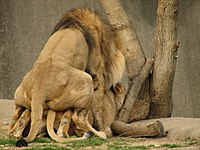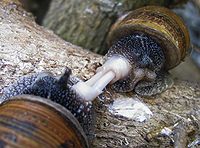Mating
This article needs additional citations for verification. (November 2013) |

In biology, mating is the pairing of opposite-sex or hermaphroditic organisms, usually for the purposes of sexual reproduction. Some definitions limit the term to pairing between animals,[1] while other definitions extend the term to mating in plants and fungi. Fertilization is the fusion of both sex cell or gamete.[2] Copulation is the union of the sex organs of two sexually reproducing animals for insemination and subsequent internal fertilization. Mating may also lead to external fertilization, as seen in amphibians, fishes and plants. For the majority of species, mating is between two individuals of opposite sexes. However, for some hermaphroditic species, copulation is not required because the parent organism is capable of self-fertilization (autogamy); for example, banana slugs.
For animals, mating strategies include random mating, disassortative mating, assortative mating, or a mating pool. In some birds, it includes behaviors such as nest-building and feeding offspring. The human practice of mating and artificially inseminating domesticated animals is part of animal husbandry.
Animals
In some terrestrial arthropods, including insects representing basal (primitive) phylogenetic clades, the male deposits spermatozoa on the substrate, sometimes stored within a special structure. Courtship involves inducing the female to take up the sperm package into her genital opening without actual copulation. In groups such as dragonflies and many spiders, males extrude sperm into secondary copulatory structures removed from their genital opening, which are then used to inseminate the female (in dragonflies, it is a set of modified sternites on the second abdominal segment; in spiders, it is the male pedipalps). In advanced groups of insects, the male uses its aedeagus, a structure formed from the terminal segments of the abdomen, to deposit sperm directly (though sometimes in a capsule called a "spermatophore") into the female's reproductive tract.
Other animals reproduce sexually with external fertilization, including many basal vertebrates. Vertebrates (such as reptiles, some fish, and most birds) reproduce with internal fertilization through cloacal copulation (see also hemipenis), while mammals copulate vaginally.
-
Mating African spurred tortoises (Centrochelys sulcata)
-
Bordered patch butterflies (Chlosyne lacinia) mating on a flower
-
Midair mating of Simosyrphus grandicornis, a hoverfly
-
Mating pair of poplar hawk-moths (Laothoe populi)
-
Ladybugs mating
-
Bugs mating (Aphrophora alni)
Plants and fungi
Like in animals, mating in other Eukaryotes, such as plants and fungi, denotes sexual conjugation[clarify]. However, in vascular plants this is mostly achieved without physical contact between mating individuals (see pollination), and in some cases, e.g., in fungi no distinguishable male or female organs exist (see isogamy); however, mating types in some fungal species are somewhat analogous to sexual dimorphism in animals, and determine whether or not two individual isolates can mate. Yeasts are eukaryotic microorganisms classified in the kingdom Fungi, with 1,500 species currently described.[3] In general, under high stress conditions like nutrient starvation, haploid cells will die; under the same conditions, however, diploid cells of Saccharomyces cerevisiae can undergo sporulation, entering sexual reproduction (meiosis) and produce a variety of haploid spores, which can go on to mate (conjugate) and reform the diploid.[4]
See also
References
- ^ The Free Dictionary. "Mate". Retrieved May 31, 2013.
- ^ The Free Dictionary. "'Fertilization' - definition of". Farlex, Inc. Retrieved 25 January 2014.
- ^ "What are yeasts?". Yeast Virtual Library. 13 September 2009. Retrieved 28 November 2009.
- ^ Neiman, A.M. (2005). "Ascospore formation in the yeast Saccharomyces cerevisiae". Microbiology and Molecular Biology Reviews. 69 (4): 565–584. doi:10.1128/MMBR.69.4.565-584.2005. PMC 1306807. PMID 16339736.









